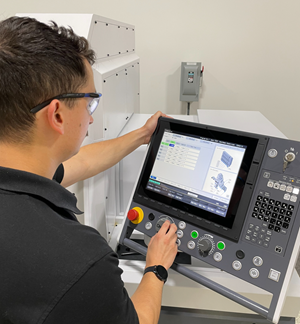Combining Absolute And Incremental Motions
While we agree that the absolute mode should be your positioning mode of choice for most applications, there are times when incremental mode can be quite helpful. Repeating motions within a subprogram, for example, is one excellent example.
Share





While we agree that the absolute mode should be your positioning mode of choice for most applications, there are times when incremental mode can be quite helpful. Repeating motions within a subprogram, for example, is one excellent example. If you have six identical pockets to mill on a machining center or six identical grooves to neck on a turning center, you can save a lot of programming effort if you specify the motions to machine one pocket or groove incrementally. Repeating the commands renders another pocket or groove.
There are even times when it is helpful to command one axis move in the absolute mode while another moves in incremental mode. Any turning center using U and W to specify incremental motions in X and Z easily allows this. Say you're experiencing some unwanted taper on a diameter and you want to program a tapering movement to counteract the problem. In the command that turns the diameter that is experiencing unwanted taper, you can specify the Z endpoint in absolute mode from program zero and the X endpoint as an incremental departure. Here is an example:
N040 G01 U-0.002 Z-2.5 F0.005听
In this command, the tool will move 0.001 inch in the X minus direction (a 0.002-inch diameter change) while the Z axis moves to an endpoint of minus 2.5-inch relative to program zero.
Though it's not common knowledge, many current model machining center controls actually allow you to specify one axis in the absolute mode in the same command as an incremental departure in another axis. This is one time when the word order within a CNC command is important. Consider this machining center command:
N060 G00 G90 X4.5 G91 Y1.0听
It will rapid the control to an X position of 4.5 inch (relative to program zero) at the same time it moves the Y axis in the positive direction by one inch. If you are in doubt as to whether your control allows this, it's easy enough to set up a test program to find out. Simply repeat the command just given a few times in a program. After the initial XY motion, each subsequent command should cause no motion in the X axis, while the Y axis moves plus one inch per command in Y.
At first glance, you may question when this method could ever be helpful. Consider a horizontal machining center that has a rotary axis. It's often helpful during approach movements to rotate the rotary axis to its first position during the X and Y approach. Since you almost always program X and Y approach movements in the absolute mode, you're likely having to specify rotary axis motion in the absolute mode as well. Or worse, you're breaking the motion into two commands, one to approach in XY and another to approach in the rotary axis. Consider this horizontal machining center approach command:
N075 G00 G90 X2.5 Y3.0 G91 B-90.0
It tells the control to move in X and Y relative to program zero (absolute mode) while the rotary axis moves in the minus direction by 90 degrees. This can really simplify the programming of the rotary axis when it's being used as an indexer. Note that at the completion of this command, most controls will be in the incremental mode, meaning the next command must include a G90 if you expect to work from program zero.
Related Content
Swiss-Type Control Uses CNC Data to Improve Efficiency
Advanced controls for Swiss-type CNC lathes uses machine data to prevent tool collisions, saving setup time and scrap costs.
Read MoreSetting Up the Building Blocks for a Digital Factory
Woodward Inc. spent over a year developing an API to connect machines to its digital factory. Caron Engineering’s MiConnect has cut most of this process while also granting the shop greater access to machine information.
Read MoreFive-Axis Machines Speed NASCAR Engine Production
Moving from an aging set of five-axis mills to more advanced machines enabled Hendrick Motorsports to dramatically improve its engine production.
Read More4 Commonly Misapplied CNC Features
Misapplication of these important CNC features will result in wasted time, wasted or duplicated effort and/or wasted material.
Read MoreRead Next
How I Made It: Dennis Rymanowski
Dennis Rymanowski has worked at NSH USA for 60 years, with his passion for manufacturing living alongside his passion for his family’s polka band.
Read MoreA New Frontier in Surface Finish Control
What if your machine tool could measure surface roughness as it cuts? This article explores how in-process metrology is advancing from concept to reality, enabling real-time feedback, immediate detection of anomalies and new levels of control over surface quality. Discover the technologies making this possible.
Read More.jpg;width=70;height=70;mode=crop)



















